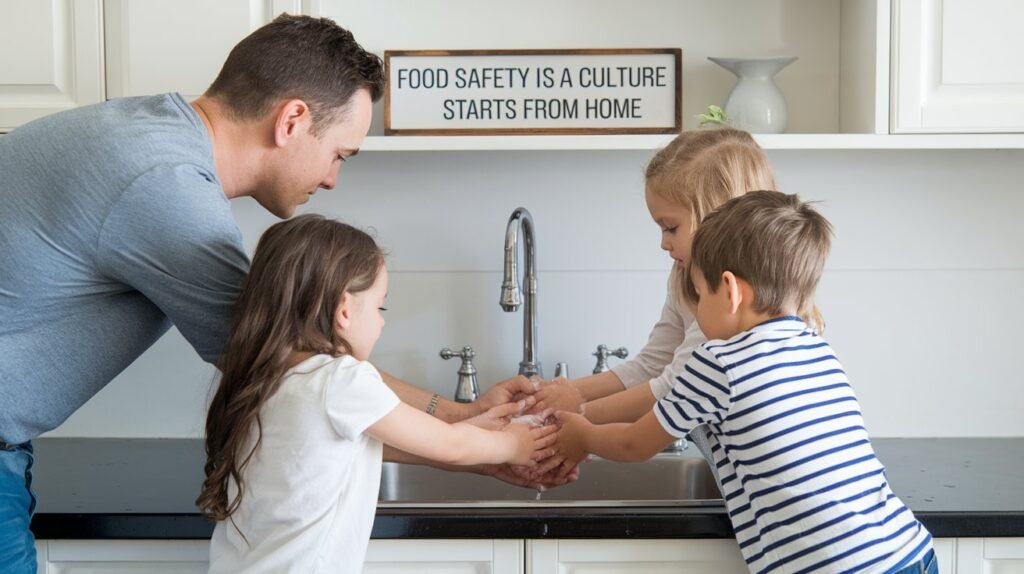Food safety culture training is a game-changer that helps ensure we’re all on the same page about protecting ourselves and others from foodborne illnesses.
When you think of food safety, your mind might immediately jump to food businesses or restaurant kitchens.
However, food safety is everyone’s responsibility, whether you’re cooking for your family, running a food truck, or managing a large restaurant.
From home cooks to food business owners, everyone benefits from understanding and embracing a culture of safety.
I remember growing up in a home where my mom always emphasized kitchen hygiene.
It seemed like she had a rule for everything—wash your hands, don’t mix raw meat with other foods, and store leftovers properly.
Those small practices became second nature to me and have stuck with me ever since.
In the same way, building a food safety culture within your family or business can have lasting effects.
Who Needs to Improve Food Safety Culture?
Food safety culture training isn’t just for chefs and health inspectors.
It’s important to every person who comes into contact with food, whether in a home kitchen or a commercial one.
Let’s dive into the different groups who need to be a part of this food safety journey.
Home Cooks and Family Members

Food safety starts at home.
Whether you’re whipping up dinner for your family or preparing snacks for your kids, the way you handle and store food matters.
And speaking of kids, teaching them early about the basics of food safety can help protect them from foodborne illnesses later in life.
It’s something I’ve practiced with my children—they love helping in the kitchen.
So I’ve made it a point to teach them how to wash their hands properly before they touch any food.
Teaching Basic Food Safety to Children

One of the simplest yet most effective lessons you can teach your kids is the importance of handwashing.
In fact, handwashing can significantly reduce the number of people who suffer from foodborne illness symptoms!
For children, this basic step prevents the spread of germs and cross-contamination
Safe Food Handling for Kids: Even when kids help with snacks, they should learn not to touch raw meat or eggs. This prevents cross-contamination.
Snack Safety: We’ve made it a habit in our home to wash fruits and vegetables, even if they look clean.
You will do the same but with one modification.
Teach your kids a small scientific reason why we need to wash fruits funnily and they will remember this forever.
Safe Kitchen Practices for Adults
For adults, basic kitchen hygiene can prevent a lot of headaches (and stomachaches).
Knowing how to organize your fridge and cook food to safe temperatures makes a big difference.
Fridge Organization: Always store raw meat on the bottom shelf to prevent drips from contaminating other foods.
This can badly affect both the safety and quality of your food!
Cooking Temperatures: Using a meat thermometer is a no-brainer.
You can’t always tell if food is fully cooked by looking at it, and eating undercooked food is very risky.
Avoiding Cross-Contamination: Don’t use the same cutting board for raw meat and veggies.
This helps keep harmful bacteria from spreading around your kitchen.
Vulnerable Family Members: Foodborne illnesses can be especially dangerous for the elderly, pregnant women, and young children.
Taking extra care when preparing meals for these groups can prevent serious health issues.
Food Business Owners and Managers

For food businesses, having a strong food safety culture training is not just a nice-to-have, it’s essential.
Your customer’s health and your business’s reputation are on the line.
I’ve carried out many food business incident investigations where one slip-up led to a recall or a wave of bad reviews online.
One example was when I was asked to make an investigation after 32 drilling rig workers were poisoned after having their dinner.
And the cause was not a big deal, they consumed their food after 4 hours from preparation.
This period was long enough to put the food in the temperature danger zone where bacterial growth was boosted.
Food safety culture training can help prevent these incidents from happening in the first place.
Food Handlers and Employees

It’s not just the managers and owners who are responsible for maintaining food safety.
Every food handler, from chefs to kitchen porters, needs to follow best practices to keep food safe
Food handlers are the most interacting persons with the food during its entire lifecycle.
They must be aware about all food safety topics that may cause foodborne illnesses.
It is always one of the most fundamentals when I conduct any food safety audit is to speak with the food handlers and employees to ensure their food safety competency level.
Client and Customer Awareness

Customers should also be a part of the food safety culture.
Educating your clients about the importance of food safety can build trust and ensure they know what to expect from your establishment.
Also, this can greatly improve your business reputation.
Displaying posters with food safety tips or offering brochures can inform customers and reinforce your commitment to their health.
Encourage customers to ask questions if they have concerns about food safety or handling.
The more transparent you are, the better your reputation will be.
What food safety culture topics need to be educated?
Personal Hygiene
This is an essential field that everyone – even kids – must know about.
It can make a great difference and significantly reduce the number of foodborne illness cases.
Good personal hygiene is one of the simplest ways to prevent the spread of foodborne illnesses.
Make sure your employees and family members understand these critical points.
• Handwashing Standards: Handwashing is the first line of defense against contamination.
Employees, food handlers, and your kids should correctly wash their hands after handling raw food and before touching anything else.
• Personal Cleanliness: Clean uniforms and avoiding accessories like watches and rings in the kitchen can prevent accidental contamination.
Handling and Storage Protocols
Proper handling and storage protocols can be the difference between a safe meal and a foodborne illness outbreak.
• Proper Food Storage: Labeling and dating stored food is key to preventing spoilage and contamination.
Here, you can learn more about the most common storage practices that can cause cross-contamination.
Restaurants may get shut down if they fail to follow this simple step.
Being aware of the FIFO system for food storage and the food storage hierarchy can protect your business from failure.
Temperature control
It is very crucial for food handlers and home cooks to know the ideal cooking temperature for each kind of food.
Because if they don’t, they can accidentally put the food in a temperature danger zone, where bacteria can grow and multiply rapidly.
Make sure staff are trained on the correct way to thaw frozen foods and reheat the leftovers to control cross-contamination and food poisoning.
How Can We Improve Food Safety Culture?
We can introduce the required food safety culture training for our staff in many ways.
1. Training and Education
One thing I always emphasize is the importance of consistent and ongoing training.
It’s not enough to train your staff once and expect them to remember everything forever.
Regular Staff Training: Whether you’re running a busy restaurant or a food truck, it’s important to have regular sessions that remind your staff of food safety practices.
In the company I’m working with, we had quarterly refresher courses to keep everyone sharp.
Also, we always make sure that our crew members have their training certificates updated and valid.
Especially when it comes to ISO-certified restaurants and food businesses, this requirement is a must.
• On boarding New Employees: Make sure new staff understand food safety basics right away.
This includes hygiene standards, safe storage practices, and the proper way to handle food.
2. Learning from Incidents
Sometimes, accidents happen, and when they do, it’s important to learn from them.
Use past incidents, whether within your establishment or from industry examples, as learning opportunities.
It is a good approach to have a register for incidents that happened in similar businesses and communicate with your staff their investigation outcomes and lessons learnt.
By analyzing the incident and near-misses with the team, you will be able to prevent similar problems in the future.
What are the benefits of improving the food safety culture?
An effective food safety culture training matrix helps reduce the risk of foodborne illnesses, which are affecting millions each year.
According to the CDC, about 48 million people get sick from foodborne illnesses annually in the U.S. alone.
That’s a staggering number and it is largely preventable with the right habits.
By improving food safety culture, you’re not only protecting health but also fostering trust with those who rely on your food, whether it’s your family or your customers.
The benefits of improving food safety culture are clear:
• Healthier Families and Customers: Fewer instances of foodborne illness.
• Better Business Reputation: A strong safety culture can lead to better reviews, customer loyalty, and less risk of legal issues.
And financially, you will avoid the economic impacts of the foodborne illness which is destructive to your business.
• Peace of Mind: Knowing that your food is prepared and handled safely allows you to focus on other things without worrying about preventable health risks.
Conclusion:
Food safety culture training is not just for food business owners.
Even your kids must be aware of the surrounding hazards.
We all have a role to play in making food safer for ourselves and others.
You can simply use many ways to improve your food safety culture.
Previous incidents are perfect teachers, we should never neglect them.
So, start today by taking small steps to improve food safety habits,
You’ll be making a big difference in the long run.



